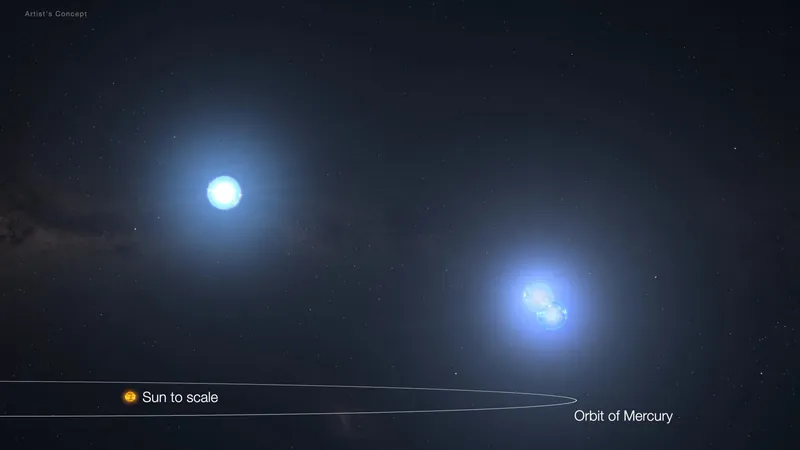
Record-Breaking Triple Star System Revealed: A Glimpse into the Cosmos' Wonders!
2024-10-02
Author: Kai
In a stunning revelation that merges technology with cosmic exploration, astronomers have identified an extraordinary triple star system known as TIC 290061484, setting a new record for the shortest orbital period for such systems. This groundbreaking discovery was made possible through the innovative application of artificial intelligence combined with data from NASA's Transiting Exoplanet Survey Satellite (TESS).
The remarkable system comprises two twin stars that orbit each other every 1.8 days, while a third star completes its orbit around the duo in a swift 25 days. This astonishing finding not only eclipses a record established in 1956, where a third star orbited its pair in 33 days, but it also propels our understanding of astrophysics into new realms.
Dr. Veselin Kostov from NASA's Goddard Space Flight Center, who spearheaded the research, shared insights on the system's configuration. “The compact nature and edge-on view of the stars allow us to gauge their orbits, sizes, masses, and temperatures accurately, providing rich data for understanding the system's formation and potential evolution,” he stated.
The star system, nestled within the constellation Cygnus, presents an ideal observational angle, where stars eclipse one another periodically, creating distinctive dimming patterns detectable from Earth. Researchers utilized machine learning to sift through vast datasets collected by TESS, identifying these intriguing starlight fluctuations. Enthusiastic citizen scientists, who played a crucial role in this endeavor, collaborated with professional astronomers to refine their findings further.
Excitingly, researchers believe that there could be many more similar systems hidden throughout our galaxy, waiting to be discovered. According to Saul Rappaport, an emeritus professor at MIT and a co-author of the study, “These systems are rare, but they might be more common than existing records suggest.”
Interestingly, this tight-knit trio of stars exhibits remarkable stability due to their nearly aligned orbits. The gravitational interactions among the stars are minimal compared to systems with tilted configurations, which often result in chaotic or unstable relationships. However, as the inner stars age, they are expected to expand and ultimately merge, potentially triggering a supernova explosion in the distant future, estimated to occur in 20 to 40 million years.
Looking ahead, astronomers are on the verge of searching for triple star systems with even shorter orbital periods. While traditional methods present challenges in identifying such systems, the impending launch of NASA's Nancy Grace Roman Space Telescope promises to revolutionize this field of study. Roman will capture images with unprecedented detail—over 36,000 times that of a single TESS pixel—allowing for high-resolution observations of densely populated regions in our galaxy.
Co-author Brian Powell from NASA anticipates that Roman’s sophisticated imaging capabilities will help uncover many previously undiscovered star systems, particularly those where all stars eclipse each other. “There’s a thrill in discovering why we have yet to find systems with even shorter orbital periods,” Powell remarked. “Roman will definitely push the limits of our knowledge and understanding.”
With Roman’s potential to reveal even more complex star systems, including those with multiple stars orbiting in synchronicity, the universe continues to surprise astronomers, hinting at a cosmos filled with intricate and bewildering phenomena.
Prepare for a future of astronomical discoveries that could redefine our understanding of star formations and their behaviors! Who knows what incredible secrets the night sky is still withholding?




 Brasil (PT)
Brasil (PT)
 Canada (EN)
Canada (EN)
 Chile (ES)
Chile (ES)
 España (ES)
España (ES)
 France (FR)
France (FR)
 Hong Kong (EN)
Hong Kong (EN)
 Italia (IT)
Italia (IT)
 日本 (JA)
日本 (JA)
 Magyarország (HU)
Magyarország (HU)
 Norge (NO)
Norge (NO)
 Polska (PL)
Polska (PL)
 Schweiz (DE)
Schweiz (DE)
 Singapore (EN)
Singapore (EN)
 Sverige (SV)
Sverige (SV)
 Suomi (FI)
Suomi (FI)
 Türkiye (TR)
Türkiye (TR)